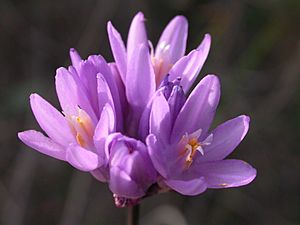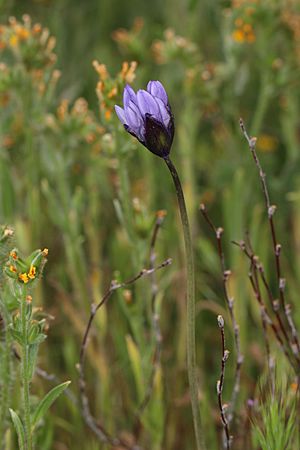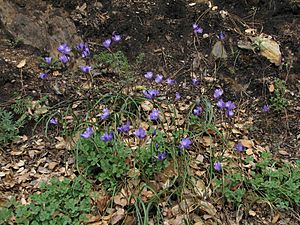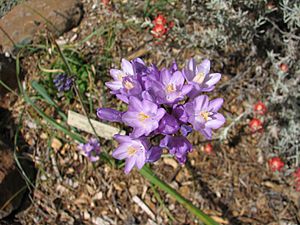Blue dicks facts for kids
Quick facts for kids Blue dicks |
|
|---|---|
 |
|
| Scientific classification | |
| Synonyms | |
|
The Dipterostemon is a special group of flowering plants. It belongs to the Asparagaceae family, which also includes asparagus! This group has only one type of plant in it. Its scientific name is Dipterostemon capitatus. You might also hear it called Dichelostemma capitatum.
People often call this plant by fun names like blue dicks, purplehead, or brodiaea. You can find it growing naturally in the Western United States. This includes places like Arizona, California, Oregon, Utah, and New Mexico. It also grows in northwest Mexico.
Contents
What Does It Look Like?
The Dipterostemon capitatus is a plant that lives for many years. It grows from a special underground bulb called a corm. This plant can grow quite tall, sometimes up to 60 centimeters (about 2 feet). It usually has 2 to 3 leaves that are 10 to 40 centimeters long.
Its flowers grow in a tight cluster, almost like a ball or an umbrella. This cluster usually has 2 to 15 flowers. The flowers can be blue, blue-purple, pink-purple, or even white. Each flower has a tube-like base, which is 3 to 12 millimeters long. Inside the flower, there are six parts called stamens. These parts help the plant make seeds. The plant also has a twisted stem that holds the flowers.
This plant can make new plants in two ways. It can grow from seeds. It can also grow from tiny new bulbs called cormlets. These cormlets grow from the main corm. They are attached by thin stems called stolons.
Dipterostemon capitatus loves to grow in open areas. It does well in places where the ground has been disturbed. It is very common to see it grow after a fire in areas like chaparral. Fires clear out other plants, giving this plant more space and nutrients. It flowers most often in March.
This plant can be found from sea level all the way up to 2,300 meters high. It lives in many different plant communities. These include vernal pools, grasslands, scrub areas, and coniferous forests. It seems to grow after fires mostly from its cormlets, not from seeds. After a fire, the plants get more sunlight. They also get more nutrients from the soil. This helps them flower strongly.
Sometimes, after a grassland fire, thousands of these plants appear. You might not have seen them there for many years before. Their corms can stay hidden underground for ten years or more. They wait for a fire or other good conditions to start growing. If fires are stopped, other plants might grow too much. This can create too much shade and competition for the Dipterostemon capitatus. This can make fewer of them grow.
How It Got Its Name
The scientific name of this plant has changed over time. In 1857, a scientist named George Bentham first described it. He called it Brodiaea capitata. Later, in 1868, Alphonso Wood moved it to a different group called Dichelostemma. So, it became Dichelostemma capitatum.
Then, in 1912, Per Axel Rydberg suggested moving it again. He put it into its own group, Dipterostemon. So, it became Dipterostemon capitatus. For a long time, most scientists still used the name Dichelostemma. But they noticed it was quite different from other plants in that group.
In 2017, scientists decided to bring back the name Dipterostemon. Now, it is accepted as a group with only one species in it. This means Dipterostemon capitatus is the only plant in the Dipterostemon group.
Different Types
There are three main types, or subspecies, of Dipterostemon capitatus:
- Dipterostemon capitatus subsp. capitatus
- Dipterostemon capitatus subsp. lacuna-vernalis
- Dipterostemon capitatus subsp. pauciflorus (This one is also called the desert hyacinth)
How People and Animals Use It
The corms (underground bulbs) of this plant were very important. Native Americans in California and other areas gathered them. These corms were a key source of starchy food for them. Different tribes and families would dig up the corms at different times. Some dug them before flowering, some during, and some after the seeds formed. Families often had special places where they would gather these corms every year.
Animals also enjoy eating these corms. Black bears, mule deer, wild pigs, rabbits, and pocket gophers all eat them. When animals eat some corms, they also help spread others around. They might detach the small cormlets. This helps loosen the soil and prepares the ground for new seeds. It also thins out the plant population, which can help the remaining plants grow stronger. When corms are separated, they might grow to flowering size faster.
Even though it takes a while to grow from seeds, this plant is sometimes used in gardens. Its blue and purple flowers look great with other native California plants. A good example is the California poppy (Eschscholzia californica). If you are patient and care for them, these plants can become very beautiful in the spring.
Caring for the Plant

Indigenous people had many ways to help these plants grow well. They wanted to make sure there would be corms to gather in the future. Here are some of their methods:
- Breaking off small cormlets from the main corms they harvested and replanting them.
- Leaving some whole plants untouched to keep growing.
- Gathering the corms after the plants had made seeds. They would then drop the seeds back into the hole.
- Burning certain areas to clear the land.
- Using irrigation to water the plants.
Digging and thinning the corms, or separating and replanting the cormlets, likely helped increase the number of plants. Digging acts like tilling the soil. This can make the gathering area bigger. It also helps air get into the soil and reduces weeds. This prepares the ground for seeds to grow better. Dipterostemon capitatus needs some disturbance to keep its populations healthy. So, the traditional harvesting methods used by indigenous people probably helped these plants thrive. If the plants get too crowded and look weak, they can be divided and separated to help them.
How to Grow It
If you plant seeds in the fall, they usually sprout easily. They don't need any special treatment. However, if you grow them from seeds, it will take several years for the plants to produce flowers. It is much easier to grow new plants from the corms themselves.



